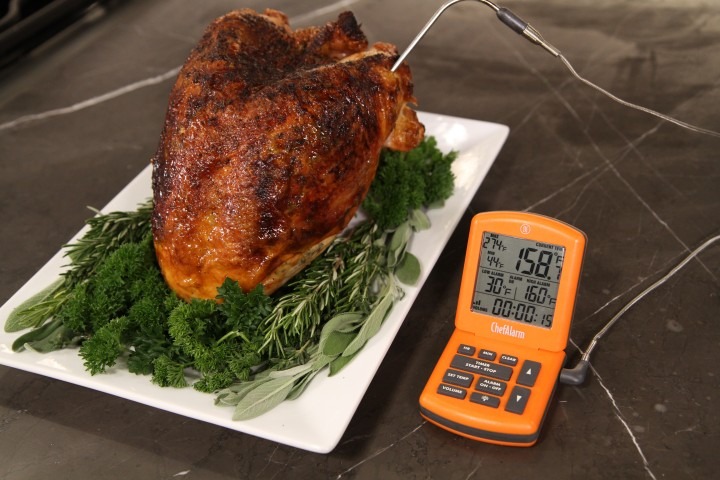When cooking turkey breasts, getting the internal temperature just right is key for moist, delicious meat. But there’s debate around the ideal doneness for turkey breast. Is the USDA-recommended 165°F the best target temperature? Or is a lower temp better for preventing dry, stringy meat? Let’s take a closer look at what the science says.
Why 165°F for Poultry?
The universal recommendation by health organizations like the USDA is to cook turkey and all poultry to 165°F as measured on a food thermometer This temperature is designed to kill any potentially harmful bacteria like Salmonella.
However, many cooking experts argue that 165°F will lead to overcooked, dried out breast meat. Let’s discuss why.
The Problem with 165°F Turkey Breasts
There are a few issues with taking turkey breasts to 165°F:
-
Breasts Cook Faster Than Thighs – Breast meat cooks much faster than dark meat The thighs may just be hitting 165°F when the breasts are pushing into the 180s.
-
White Meat is Lean – Turkey breasts are very lean without much fat or collagen. This makes them prone to drying out.
-
Carryover Cooking – After removing the turkey from the oven, residual heat will continue raising the internal temperature 5-10°F.
These factors combined mean that 165°F turkey breasts will likely end up overcooked and dry by the time they are served
Lower Target Temperatures for Moist Turkey Breasts
Many chefs and cooking experts recommend taking turkey breasts to a lower final temperature between 150-160°F for the best moisture and texture. Here are some popular target temperatures:
-
150-155°F – This is the lowest recommended temperature for turkey breasts. It allows for plenty of carryover cooking while keeping the meat very juicy. However, some may prefer breasts cooked to a higher temp.
-
157-160°F – This is a happy medium target temp. It produces a juicier breast than 165°F, while fully coagulating the proteins for meat that is nicely firmed up.
-
165°F – Going to the full USDA-recommended temp is safest for killing bacteria. But the tradeoff is the breast meat will be drier. Reserve 165°F for the thighs which have more fat and collagen.
How to Cook Turkey Breasts to the Perfect Temperature
Here are some tips for nailing the ideal doneness on your turkey breasts:
-
Use a Meat Thermometer – Ditch the pop-up timer and use a reliable instant read or probe thermometer. This lets you monitor the temp with precision.
-
Temp Thicker Parts – Focus on temping the thickest, meatiest areas of the breast and avoid bones.
-
Pull 10°F Before Target – Yank the turkey around 150-155°F and let carryover cooking take it up to a perfect 157-160°F.
-
Tent and Rest – Allowing the turkey to rest under foil after cooking gives carryover time to work.
-
Check in Multiple Spots – Double check temperature in a couple spots to confirm even doneness.
-
Monitor When Reheating – If reheating leftovers, verify internal temp again reaches 165°F.
The Takeaway
For the juiciest turkey breast possible, pull it before it hits the USDA-recommended 165°F. Instead target an internal temperature of 157-160°F. This lower temp prevents the lean breast meat from drying out while still being hot enough for food safety. Use a good digital meat thermometer and employ carryover cooking to nail this ideal temperature every time.
Frequently Asked Questions
Is it safe to eat turkey breast under 165°F?
Turkey breast cooked to at least 155°F is considered safe by the USDA. The pasteurization time required to kill bacteria drops as the temperature rises. While 165°F turkey is safest, at 157-160°F the meat is still held hot enough and long enough to adequately kill pathogens.
Should I brine turkey breasts?
Brining is highly recommended for keeping turkey breasts extra juicy. Soaking in a saltwater solution before cooking enhances moisture and flavor. Make a simple brine of 1 cup salt per gallon of water. Submerge the breasts for 2-6 hours before roasting.
What is the best way to thaw turkey breasts?
Thaw frozen turkey breasts in the refrigerator 1-2 days before cooking. Place it on a plate or in a pan to catch drips. Do not thaw at room temp as bacteria could multiply in the danger zone above 40°F. Thawing in the fridge keeps it safely chilled.
How long should I roast bone-in turkey breasts?
Roast bone-in, skin-on turkey breasts for approximately 18-25 minutes per pound at 350°F. A 5 pound breast would take 1.5-2 hours based on this estimate. Use a meat thermometer for the most precision.
Is stuffing baked inside turkey breasts safe?
It is not recommended to cook stuffing inside any poultry. The stuffing needs to reach a full 165°F which the inside of turkey might not achieve. Cook stuffing separately to prevent bacterial growth.
Can I smoke a turkey breast like a brisket?
Absolutely! Smoking turkey breasts “low and slow” after brining results in exceptionally moist meat. Cook at 225-250°F to an internal temp of 155-160°F for the best texture. Allow 1-1.5 hours per pound.
What is the best way to roast a turkey breast?
For the juiciest oven-roasted turkey breast, use a rack in a roasting pan with 1 cup broth or water added. Roast at 350°F until the thickest part of breast reaches 155-160°F. Let rest at least 15 minutes before slicing.
What sides go well with roasted turkey breast?
Some classic Thanksgiving sides that pair beautifully with roasted turkey breast include mashed potatoes, gravy, stuffing, roasted veggies like Brussels sprouts, cranberry sauce, and dinner rolls. Get creative with your favorite fall vegetable dishes too.
Can you cook a frozen turkey breast?
It is safe to cook a completely frozen turkey breast straight from the freezer. Add 50% more cooking time and roast at 325°F. The USDA says frozen poultry can be cooked within one year for best quality. Use a thermometer to confirm it reaches a safe final temperature.

